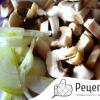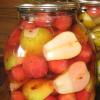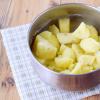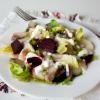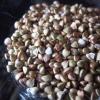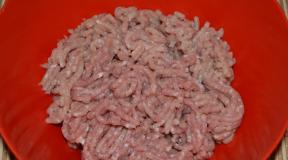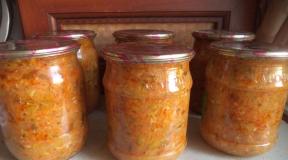Dried garlic - how to make it, its benefits and harm. How to properly dry garlic at home
Garlic is the sweetest vegetable. Its beneficial properties are known to everyone. This healthy vegetable is also used for preparing various dishes, because it improves the taste of the dish and also increases appetite. Garlic is easy to store at home, but if you don't have space to store it, you can dry the vegetable. This will be discussed in our article.
Rules for preparing garlic
To dry garlic, it needs to be prepared for this process. First of all, before digging up the garlic, do not water it for a couple of days. Dig up ripe garlic, you can tell by the leaves. Garlic should also not be overripe, because it will be difficult to dry. Choose a healthy, clean vegetable so that there are no cuts, stains, etc. on it. Drying garlic is possible in several ways, namely in cloves, slices or in powder form.
How to properly dry garlic braided?
After you dig up the garlic, dry it by leaving it on the ground for a couple of days. If you see that the weather conditions are not very favorable, then for drying, choose a warm room where the vegetable will dry for a week. When the leaves are dry, trim them or braid them with garlic tops and hang them to dry further.


How to properly dry unpeeled garlic?
- Peel the garlic, removing the outer skins, but do not destroy the bulb.
- Next, cut the head of garlic into 5 mm slices each.
- Then place them on a baking sheet, having previously covered it with parchment, and dry in the oven at 50 degrees. Stir the garlic occasionally to ensure it dries evenly.
- If the slices do not bend, but break easily, then it is already dried.
- Remove the dried garlic cloves from the oven and leave to cool. When they have cooled, ventilate them to separate them from the scales, and place the ready-made garlic in a box or jar with a lid.
- To store such garlic, a dry, dark, cool place is suitable, where it can be stored for almost a year.
- You can also dry the garlic cloves in the sun, but this will take longer and you will need to be careful not to get them wet from the rain.


How to properly dry peeled garlic?
- Divide the garlic head into cloves, peel them, and cut off the root collar.
- Select good cloves and cut them in half.
- Place the cloves cut side up on a baking sheet, previously covered with parchment paper, and dry in the oven at 50-60 degrees.
- Stir the garlic from time to time.
- If the cloves break easily, they are ready and can be removed from the oven.
- Once you have cooled it, you can pack it. To do this, use paper bags or glass jars with lids.


How to make garlic powder?
Dry and cool the garlic slices, then grind them into powder using a coffee grinder or blender. Sift the powder and store in jars that seal well. This powder can be stored for almost a year.


Choose any of the methods we offer and make preparations. Prepare delicious dishes using your ingredients. Eat garlic and be healthy!
The spicy aroma of garlic stimulates the appetite and goes well with many dishes. How to dry garlic correctly so that you have a healthy spice on hand even in winter? Find out in this article.
How to dry garlic correctly?
How to dry garlic after digging?
An important condition for preparing garlic heads is digging them out correctly. If you grow it yourself, you should stop watering the plants a couple of days in advance; they should be dug out from completely dry soil.
The next important condition is that the garlic is not washed. The top layer of the shell is simply removed. Washed can rot from moisture.
If you are going to dry the heads, do not cut off the stems and roots - they can easily determine the readiness of the product. As soon as these parts turn yellow evenly and become brittle, it can be stored.
Garlic is dried in the following ways:
- in a well-ventilated, cool room, lay out the heads in one layer and leave until completely dry. True, such drying lasts 1-2 months. At the end, remove the roots and leaves from the garlic, leaving small areas on both sides so as not to expose the cloves;
- sliced or whole cloves are dried in an electric dryer, spreading thinly in bowls and setting the temperature to 50 degrees;
- An oven is suitable for drying - the garlic is dried in a thin layer on a baking sheet with the door ajar and a temperature of 50 degrees;
- if you have a convection oven, then use the “Drying” mode, placing the plates in one layer on a special grill;
- You can not just chop, but grind the garlic in a food processor, then you can dry it in the oven at a temperature of 90-95 degrees. In an electric dryer, such a product will dry for two days at a temperature of 35 degrees.
Garlic powder can also be obtained from dried cloves - they are ground in a coffee grinder.
How to store dried garlic
Dry product heads can be stored in old stockings or wooden boxes in a dark, low-humidity area. Cloves and slices are stored in glass containers with a tight-fitting lid. The powder can also be stored in glass or tightly sealed bags with foil.
Garlic is an excellent seasoning for many dishes - soups, side dishes based on rice and pasta, homemade sausages, pickled and salted vegetables. It is equally good fresh or dried. Thanks to the latter, you can delight your household with spicy dishes all year round. You just need to know how to dry garlic at home.

In conjunction
Garlic can be dried immediately after digging it out of the soil. Just leave the crop in the garden for a few days. This time is enough for the garlic itself to ripen and its tops and roots to dry. If the weather is rainy outside, drying is carried out in a warm, dry room at a temperature of about +30 ° C.
When the tops become dry, the garlic should be carefully braided and hung in a cool, dry room (basement, cellar or pantry).
In unpeeled onions
Unpeeled garlic can be dried in a well-ventilated cool room (maximum air temperature should be +10 ° C).
- Place the garlic on the floor or table in a single layer and be patient for 1-2 months. The plant will gradually dry out, its leaves will turn brown, and its roots will become noticeably shriveled.
- After this, carefully trim the roots, leaving 0.5 cm from them, and the stems at a height of about 2–2.5 cm from the head.
- Peel the garlic carefully, but leave a little to preserve the integrity of the head.
You can store garlic dried in this way in stockings in a dark corner or in a pantry.
Peeled garlic
Some housewives prefer to dry the garlic immediately, peeled, thereby saving themselves time in the future.
- Peel the cloves.
- Cut into small pieces approximately 6mm thick.
- Place the pieces on a baking sheet and place in the oven preheated to +50 °C.
- Once the garlic is dry, cool it at room temperature and pack it into jars for storage.
Garlic powder
If desired, you can grind dried peeled garlic into powder. In this form, the spice is very convenient to use during cooking. Just put it through a coffee grinder. Store the finished seasoning for a year.
If you wish, you can dry the chopped garlic immediately. For this:
- Peel the heads, divide into slices, remove the shell and finely chop. Grating garlic is not recommended, as this may cause the product to lose a lot of juice and become tasteless.
- Dry the chopped garlic in the oven at a temperature of +95 °C or in a special dehumidifier (a temperature of +35 °C and two days will be required).
- Crushed garlic can also be powdered using a coffee grinder or high-powered blender.
Dried garlic should always be on hand for a skilled housewife. It will easily add piquancy and a unique aroma to the dish. Just remember that only fully mature and absolutely healthy heads are suitable for drying at home.
Dried garlic: the healing properties of the beneficial components included in its composition, can excessive consumption of the product cause harm. Recipes for dishes that complement spices best.
The content of the article:
Dried garlic is the dried and crushed root of a perennial plant of the same name from the Allium family. The birthplace of culture is Central Asia. Since ancient times, it has been valued for its exceptional taste and healing effects on the body. There is handwritten evidence according to which the Egyptians made 22 medicines based on dried garlic to treat various ailments. Today it is used mainly as a spice. It is added to recipes for a variety of dishes all over the world. In our country, garlic is very popular, both fresh and dry, but we are far from the world leaders in eating the plant - in Italy, China and Korea, each resident eats about 8-12 cloves per day.
Composition and calorie content of dried garlic

Many people believe that dried garlic does not retain nutrients. However, if you perform the drying procedure correctly, observing the temperature regime, most of the elements useful and necessary for the human body will be preserved.
Calorie content of dried garlic is 331 kcal per 100 g of product, of which:
- Proteins - 16.55 g;
- Fats - 0.73 g;
- Carbohydrates - 72.73 g;
- Dietary fiber - 9 g;
- Water - 6.45 g;
- Ash - 3.54 g.
- Potassium - 1193 mg;
- Calcium - 79 mg;
- Magnesium - 77 mg;
- Sodium - 60 mg;
- Phosphorus - 414 mg.
- Iron - 5.65 mg;
- Manganese - 0.979 mg;
- Copper - 533 mcg;
- Selenium - 23.9 mcg;
- Zinc - 2.99 mg.
- Vitamin B1 - 0.435 mg;
- Vitamin B2 - 0.141 mg;
- Vitamin B4 - 67.5 mg;
- Vitamin B5 - 0.743 mg;
- Vitamin B6 - 1.654 mg;
- Vitamin B9 - 47 mcg;
- Vitamin C - 1.2 mg;
- Vitamin E - 0.67 mg;
- Vitamin K - 0.4 mcg;
- Vitamin RR, NE - 0.796 mg;
- Betaine - 6.1 mg.
- Arginine - 3.365 g;
- Valine - 0.667 g;
- Histidine - 0.263 g;
- Isoleucine - 0.414 g;
- Leucine - 0.728 g;
- Lysine - 0.768 g;
- Methionine - 0.111 g;
- Threonine - 0.374 g;
- Tryptophan - 0.121 g;
- Phenylalanine - 0.525 g.
- Omega 3 - 0.012 g;
- Omega-6 - 0.165 g;
- Saturated - 0.249 g;
- Monounsaturated - 0.115 g;
- Polyunsaturated - 0.178 g.
Beneficial properties of dried garlic

Healers from many countries wrote about the healing abilities of the plant in ancient times. Its unique beneficial properties are still recognized today. Garlic, including dried garlic, is included in many medicines. It is valued primarily as a natural antibiotic, and the fact that the plant can effectively fight bacteria was scientifically proven by Louis Pasteur in the 19th century.
In addition, garlic is an excellent antiseptic due to the presence of phytoncides and a source of antioxidants due to the content of allicin in the essential oils of the plant.
Let's look at the beneficial effects of the plant in more detail. The benefits of dried garlic include the following positive effects:
- Preventing the development of inflammation. The above-mentioned phytoncides actively fight pathogenic flora, preventing inflammatory processes of one nature or another. They are capable of killing a wide range of viruses, bacteria, fungi, etc.
- Strengthening the cardiovascular system. The positive effect of dried garlic on the heart is to increase the force of contractions, as a result of which it conserves resources, but at the same time functions more efficiently. The benefits for blood vessels are explained by preventing the formation of cholesterol and preventing atherosclerosis. Consumption of spices protects blood vessels from damage, which in turn reduces the likelihood of developing thrombosis. Garlic also dilates blood vessels, thus preventing a hypertensive crisis.
- Prevention of respiratory diseases. The spice has a particularly beneficial effect on the mucous membranes of the respiratory tract, preventing the development of colds. The plant is used not only for prevention, but also for the treatment of bronchopulmonary diseases, due to the effective relief of inflammation and due to its ability to dilute sputum and promote its separation.
- Prevention of cancer development. Garlic can fight the development and growth of tumors thanks to allicin - it is a powerful antioxidant and prevents the formation of free radicals.
- Increasing the body's immune forces. Of course, a spice so rich in beneficial components cannot but have an overall positive effect on the immune system. Regularly adding dried garlic to dishes will help you avoid getting sick during flu and ARVI epidemics.
- Normalization of the gastrointestinal tract. The enzymes contained in the spice stimulate metabolic processes, help the digestive system digest food more efficiently, absorb beneficial substances and remove harmful ones. The product also has a positive effect on intestinal motility and helps fight intestinal disorders.
- Prevention of liver diseases. Garlic has choleretic properties, due to which bile is promptly removed from the body, facilitating the functioning of the liver. The choleretic effect also prevents the formation of bile clots and stones.
- Beneficial effect on the functioning of the gonads. The spice plays the role of an aphrodisiac, activating the work of both the female and male sex glands. In addition, some of the beneficial substances are excreted in the urine, which helps disinfect the genitals and prevents the development of specific infections.
- Brain stimulation. Garlic has a beneficial effect on brain activity, which is especially important for older people. Regular consumption of the spice prevents brain degradation and senile dementia.
- Preventing premature aging. The presence of antioxidants in garlic not only helps prevent the development of tumor processes, but also helps prevent early aging.
- Prevention of vitamin deficiency. The presence of vitamins in garlic protects the body from their deficiency.
Harm and contraindications to dried garlic

Unfortunately, even such a healthy product as dried garlic can harm the body. Anyone should not abuse this spice. Garlic contains a lot of really powerful biologically active substances, most of them are beneficial, but there are also some that can lead to adverse effects if not observed in moderation. When overeating spices, a person may feel a headache, become absent-minded and inattentive.
In addition, there is a group of people who are not allowed to consume garlic in any quantity or who are advised to strictly dose its use. Among these people:
- Suffering from severe diseases of the stomach, liver and kidneys. The spice irritates the mucous membranes and can cause an exacerbation of the disease.
- Epileptics. Garlic can trigger an attack.
- Pregnant and lactating women. Some components included in the product may adversely affect the fetus. During lactation, the spice is prohibited, since the baby may be allergic to garlic, which in small quantities will certainly pass into breast milk.
- Suffering from other serious illnesses. Among them are anemia, diseases of the genitourinary and cardiovascular systems. Let us repeat, garlic is a strong product in all respects, and therefore, if you have a particular disease, consult your doctor before consuming it.
There are studies according to which garlic is a poisonous plant due to the presence of so-called sulfanyl-hydroxyl ions in it. It is considered toxic to the entire body and has a particularly negative effect on the brain. The authors of the study assure that the product should not be consumed even in small doses. However, the official point of view so far is this: only the abuse of garlic can lead to negative consequences, but in moderate doses, the product, on the contrary, is extremely beneficial.
Recipes with dried garlic

Garlic has a special place in cooking. In any form, it is one of the main spices of Mediterranean cuisine. This spice is also loved in South and East Asia, the Middle East and North Africa. However, using dried garlic in recipes is a common practice all over the world. There are many signature dishes with spice.
In dried form, garlic is especially good when added to soups, hot dishes of meat and vegetables, as well as sauces. Let's look at some great recipes:
- Homemade chicken sausages. Grind chicken fillet (250 grams) in a blender or pass through a meat grinder. Mix spices: paprika (1 teaspoon), thyme (1 teaspoon), black pepper (0.5 teaspoon), dried garlic (0.5 teaspoon). Add all the spices to the minced meat and mix. Add grated cheese (150 grams) and mix again. Form small sausages from the minced meat, roll them first in cornstarch, then in beaten egg and finally in breadcrumbs. Place in the freezer for 2 hours. Fry in a frying pan until done.
- Festive potato side dish. Cut the potatoes into very thin slices (1 kg), place in a bowl. Add spices: dried garlic (1 teaspoon), thyme (1 pinch), pepper and salt to taste. Next, add melted butter (2 tablespoons) and vegetable oil (2 tablespoons), as well as grated cheese (50 grams). Mix everything well. Take a muffin tin and stack the herbed potato slices into the “well” for each muffin. Bake at 220 degrees for 40-50 minutes. You should get some kind of potato nests; you can serve them in portions.
- Zucchini chips. Cut zucchini (500 grams) into slices and add salt. Mix breadcrumbs (150 grams) and spices - dried garlic (0.5 teaspoon), suneli khmeli (1/3 teaspoon). Dredge the zucchini in flour, then in beaten egg and finally in spiced breadcrumbs. Place on a baking sheet and cook in the oven for 15 minutes at 200 degrees, then turn over and cook for another 15 minutes. It is best to eat zucchini chips with a sauce made from sour cream and chopped fresh garlic.
- Barbecue sauce. Pour your favorite ketchup (250 grams) into the pan; you can replace it with tomato paste, slightly diluted with water. Add sugar (2 tablespoons), vinegar (2 tablespoons), honey (1 tablespoon), mustard (1 teaspoon), a pinch of spices: dried garlic, onion, celery, paprika, black pepper and salt. It would be ideal to also add Worcestershire sauce (2 tablespoons), but finding it in our stores is not so easy. Place the future sauce on low heat and cook after boiling until thickened - 10-15 minutes. If the sauce does not thicken, add a little starch.
- Lentil soup. Pour lentils (100 grams) with water (2 liters), bring to a boil and cook for 20 minutes. Cut the potatoes (3 pieces), onion (1 head) and celery stalk (1 piece) into cubes, grate the carrots (1 piece). Fry all prepared vegetables, except potatoes, in a frying pan. Add all ingredients to lentils, cook for 15 minutes. Add dried garlic (1 teaspoon), soy sauce (1 tablespoon), lemon juice (2 teaspoons), salt and pepper to taste. Cook for a couple more minutes.
Note! Dried garlic should be added to all dishes 2-3 minutes before cooking, so as not to lose all the beneficial components during heat treatment.

Indians began cultivating garlic in ancient times, but for a long time it was used purely as a component of medicines. The plant was not used in cooking because the smell was too pronounced.
The ancient Egyptians believed that people engaged in heavy physical labor must eat garlic regularly. The spice was present in the diet of the builders who were engaged in the construction of the pyramids.
There is reason to believe that ritual significance was also attributed to garlic in Egypt. During excavations in the tombs of the pharaohs, archaeologists repeatedly discovered cloves of garlic in front of noble people.
Garlic is even mentioned in the Bible. And, again, the mention is associated with Ancient Egypt, or rather with a description of the diet of its inhabitants, according to which they ate a lot of garlic and onions.
In Korea and Japan they prepare an unusual dish - “black garlic”, which is obtained by preserving the cloves using a certain technology. This garlic has a sickly sweet taste.
In Slavic mythology, spices were credited with magical properties. It was believed that it helps drive away evil spirits and witches, as well as diseases. In the south of Russia there was a belief that garlic must be tied into the bride’s braid to ward off damage.
There is an interesting legend about the plant in Ukraine. It is believed that it grew from the teeth of an evil witch, and therefore eating it is a sin. And, nevertheless, traditional Ukrainian borscht cannot do without this spice.
In 1998, a garlic festival was established in the United States, which is still held today. All funds are transferred to the children's fund to combat mental disorders.
In 2009, when the swine flu epidemic was raging in China, someone spread a rumor that garlic could help treat it successfully. Thanks to this gossip, prices for fragrant cloves increased almost 40 times.
Watch a video about dried garlic:
Garlic is a unique product both in the culinary world and in folk medicine. Its bright taste and aroma have given it a reputation in the kitchens of all countries of the world, and its many beneficial properties have made it a favorite of people who prefer to be treated with traditional methods. At the same time, there are studies according to which garlic is poisonous and should not be eaten even in small doses, but the studies have not yet been officially recognized.
You can say about garlic the same way as about onions - it is “from seven ailments.” But garlic not only helps to avoid many diseases and cure existing ones, but is also a vegetable that improves the taste of a dish and increases appetite.
Garlic can be stored well at home. But if there is a lot of it, for example, you have your own garden with a garlic bed, but there is nowhere to store it (although there may be other reasons), then the garlic can be dried. After all, this is not such a labor-intensive process as it seems at first glance. Dry garlic also takes up little space and is very convenient to use.
How to prepare garlic for drying
The following varieties of garlic are suitable for drying: Kirovogradsky, Starobelsky White, Southern Violet, Bronitsky, Ukrainian White, Kalininsky, Rostovsky, Creole and others.
If you are harvesting your own garlic, do not water it for several days before digging it up, since the soil must be completely dry. For the same reason, they do not dig immediately after rain.
The garlic must be ripe. This is evidenced by the leaves themselves, which turn yellow and fall to the ground.
If you dig up garlic that is not yet fully ripe, its bulbs will be loose and loose. They will be poorly stored and dry.
But overripe garlic is also not very good, since when it is dug up, the scales are easily separated from the heads, as are the cloves themselves. This makes further processing difficult. After all, the cloves can become stained with soil, and it is not recommended to wash garlic that is going to be dried. Such garlic will take a very long time to dry and may simply become moldy and spoiled.
Only healthy, clean, undamaged and fully formed garlic is suitable for drying.
Garlic is dried by taking it into pieces, cutting it into slices or making powder out of it.
How to dry garlic in a bunch
Immediately after digging, the garlic needs to be dried. Primary drying is carried out directly in the field. To do this, it is pulled out of the ground and left to lie there for several days. During this time, the tops and roots will dry out and the garlic will ripen. The scales will also dry out and press tightly against the bulb. In rainy or cold weather, drying is carried out in a warm room at a temperature of about 30°C for six to eight days.
When the tops dry, they are cut off, leaving a small stump. But most often, garlic and tops are braided into braids and hung by them in a dry, cool room.
How to dry garlic without destroying the bulbs
Garlic is peeled from the upper hard scales without destroying the bulb itself.
Then the garlic is cut into pieces 5 mm thick.
Place on sieves or baking sheets lined with parchment and dry in an oven or oven at a temperature of about 50°C. To avoid steaming or uneven drying, the garlic should be stirred periodically.
Garlic can also be dried in the sun, spread out in a thin layer. But this method is inconvenient because you need to make sure that moisture from rain or dew does not get on the garlic.
Garlic is considered dried when the slices no longer bend and break easily.
The crushed garlic is well cooled by placing it on a cloth or on the same sieves.
The garlic is then winnowed by hand to separate the slices from the flakes.
Ready garlic is packaged in boxes, paper bags, hermetically sealed glass jars and stored in a dry, dark, cool room for about a year.
How to dry already peeled garlic
Garlic heads are disassembled into cloves and completely peeled. The root collar of the cloves is cut off. Check that the cloves are free of damage and brown spots.
Some people advise grating the garlic, but this method releases a lot of juice, which makes drying the garlic almost impossible. You can chop the garlic using a food processor, but the slices should not be very wet. Therefore, the best cutting method is still manual. That is, armed with a sharp knife, the cloves are cut into thin slices and immediately laid out on a baking sheet covered with parchment.
This garlic is dried in an oven or electric dryer at a temperature of 50-60°C.
The chopped garlic is periodically stirred with a spatula and ventilated, occasionally opening the door. This must be done so that the raw materials do not steam and dry evenly. Drying continues for several hours.
Method 2. Garlic is disassembled into cloves, peeled and the root collar is cut off. The cloves are cut in half. They are laid out in one layer on a baking sheet lined with parchment, cut side up. Dry in an oven or oven in the same way as in the previous case.
The drying time depends on the quality of the garlic, the degree of grinding, the drying temperature and the choice of drying unit.
Ready dried garlic breaks easily.
It is cooled in air and packaged in paper bags or hermetically sealed glass jars.
How to Make Garlic Powder from Dried Garlic
Well-dried and cooled garlic slices are ground in a coffee grinder or blender until powdered. Then sift through a sieve so that the resulting powder is homogeneous. You can chop the garlic to coarse crumbs, then the prepared topping will taste good in the dish.
If the garlic cloves do not chop well, it means they are not dried enough. You need to additionally dry them in the oven, cool again and grind.
Store garlic powder in glass, well-closed jars. Shelf life is about a year.



